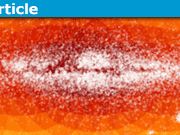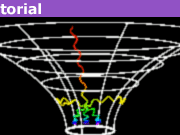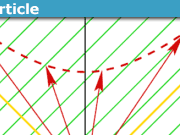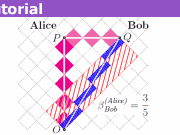Learn Time Dilation and Redshift for a Static Black Hole
The following is an overview of the time dilation and gravitational redshift effects of a static (Schwarzschild) black hole. By general relativity, a strong gravitational field can slow downtime. The closer you get to the event horizon of a black hole (if you can survive the gravity gradients, and g-forces and have some means of propulsion that will keep you stable in the overwhelming gravity), there will appear no difference to yourself but time will pass slower for you and quicker for people outside the field (with no apparent difference to them either). On returning from the edge of the black hole, depending on how close you were to the event horizon and how long you were there, you would have aged less than the people outside the black hole’s strong gravitational field. This can be calculated using the following equation-
[tex]\tau=t\sqrt{1-\frac{2Gm}{rc^2}}[/tex]
which can be rewritten as
[tex]\tau=t\sqrt{1-\frac{r_s}{r}}[/tex]
where [itex]\tau[/itex]- actual (proper) time experienced within black holes gravitational field, [itex]t[/itex]- time observed from infinity, [itex]r_s[/itex]- Schwarzschild radius of black hole (where [itex]r_s=2Gm/c^2[/itex]), [itex]r[/itex]- the coordinate radius time was spent at ([itex]G[/itex]- gravitational constant, [itex]m[/itex]- mass, [itex]c[/itex]- speed of light).
For example, if an observer was to spend an ‘observed’ 3 days at 1 km from the event horizon of a 12,000* solar mass black hole, they would only experience-
[tex]\tau=3\sqrt{1-\frac{35,444,396}{35,445,396}}[/tex]
[tex]\tau=0.01594\ \text{days = 23 minutes}^{**}[/tex]
where t=3 days, [itex]r_s=2Gm/c^2[/itex] which for a 12,000 solar mass black hole equals 35,444,396 m and to be 1 km from the event horizon would mean r=rs+1000 m=35,445,396 m
*A 12,000 solar mass BH was chosen due to the tolerable tidal forces (dg) near the event horizon, [itex]dg=(2Gm/r^3)dr[/itex] where dr=2 (approx. height of a person), which means dg=71.5 g which is 7.3 earth g from head to toe which is just about manageable.
**That is, if they instantaneously travel to the mark and travel instantaneously back again, otherwise time dilation would need to be taken into account for the various stages of the trip.
Likewise, due to the immense gravity, the electromagnetic information being sent out by a person would be extremely redshifted. This can be calculated using the following equation-
[tex]z=\frac{1}{\sqrt{1-\frac{2Gm}{rc^2}}}-1[/tex]
(black hole event horizon = surface of infinite redshift)
and to calculate the actual change in wavelength-
[tex]z=\frac{\lambda_o – \lambda_e}{\lambda_e}[/tex]
which becomes
[tex]\lambda_o=(z \cdot \lambda_e) + \lambda_e[/tex]
where [itex]\lambda_o[/itex]- wavelength observed from infinity and [itex]\lambda_e[/itex]- wavelength emitted from the object.
Therefore, the redshift at 1 km from the event horizon would result in z=187.27. Information at a wavelength of 550 nm (the color green in the visible spectrum) [itex](\lambda_e)[/itex] would be stretched to a wavelength of 103,549 nm (0.10355 mm or 103.55 um) [itex](\lambda_o)[/itex] which would put it in the FIR wavelength (far-infrared light waves) (in comparison, the sun has a surface gravitational redshift of z=0.0000021 which has near to zero effect on the electromagnetic information. A white dwarf with a 1.14 sol mass and a 4.5×10^6 m radius has a gravitational redshift of z=0.00037. For a neutron star with a 2 sol mass and a 12 km radius, z=0.4034.). The strong gravitational field would have the opposite effect on light going the other way as it was pulled in towards the event horizon. Viewed from outside the strong gravitational field, the individual would appear to slow down and disappear over time as the light coming from them was redshifted towards radio waves, but from the inside, the observer might see the outside 3 days pass in the 23 minutes they spent at 1 km from the event horizon. It’s very likely that this light would be blue shifted into the x-ray and gamma-ray spectrum which would no doubt have fairly drastic consequences for the observer.
Imagine a spaceship is at 1,000,000 km from a 12,000 solar mass black hole (even here, the craft would have to have powerful engines for it not to be pulled in by the gravity of the black hole which would still be 1,511,711 m/s^2*** at this point). Gravitational redshift would be minimal (550 nm [itex](\lambda_e)[/itex] would be 560 nm [itex](\lambda_o)[/itex], green would still be green). Here, time dilation would already be beginning to take effect (~59 minutes would pass compared to every hour in regular space outside the black holes gravitational field). A scout ship with the capacity to travel over 1,000,000 km almost instantaneously (an average velocity of 30,000 km/s, 0.1c, covering the 1 million km in ~35 seconds. Time dilation due to this velocity is virtually undetectable) is sent out towards the black hole. Due to the velocity of the craft, it would appear orange to the main ship for the majority of the journey but as it reached the 100,000 km mark from the event horizon, it would begin to turn deep red (light wavelengths from the scout ship would be stretched from 600 nm to 650 nm due to gravitational redshifting). At around the 50,000 km mark, it would disappear to the naked eye and the observer ship would have to use infrared equipment to monitor the scout ship’s progress. As the scout ship passed the 10,000 km mark it would appear to slow down as time dilation meant that 30 seconds for the scout ship would appear as 1 minute for the main ship (the scout ship would appear to be half its speed). By the time the ship reached the 1 km mark from the event horizon, it would be in far-infrared. It would be seen to hover for 3 days, visible only to infrared equipment on the main ship, the crew had plenty of time to monitor the scout ship’s position. After a full 3 days at the 1 km mark, the scout ship would at first appear to slowly make its way back to the ship, picking up speed as it went through far, mid, and near-infrared, back into visible light, 100,000 km from the event horizon, appearing nearly full speed now as the time dilation here is only 0.85 (1 minute for the main ship would be ~52 seconds for the scout ship). Over the remaining 900,000 km, the ship would appear blue due to its velocity. Once the scout ship had returned, it would inform the crew of the main ship that it had been traveling at maximum speed all the way, taking only 35 seconds to arrive at the 1 km mark where it hovered for just 23 minutes before accelerating away at full power to arrive back at the main ship.
***Gravity for a static black hole is [itex]g=Gm/(r^2\sqrt(1-r_s/r))[/itex].
Time dilation and gravitational redshift become more extreme the closer you get to the black hole, at 1 m from the event horizon (r=rs+1 m), you would only experience-
[tex]\tau=3\sqrt{1-\frac{35,444,396}{35,444,397}}[/tex]
[tex]\tau=0.0005\ \text{days = 43 seconds}[/tex]
The redshift would be z=5,957.83 (550 nm (green) [itex](\lambda_e)[/itex] would be at 3,277,358 nm or 3.277 mm [itex](\lambda_o)[/itex], which would put it in EHF, Extremely high-frequency radio waves, detectable only by radio receivers)
and at 5 mm from the event horizon (r=rs+0.005 m)-
[tex]\tau=3\sqrt{1-\frac{35,444,396}{35,444,396.005}}[/tex]
[tex]\tau=0.000036\ \text{days = 3 seconds}[/tex]
The redshift would be z=104,962.52 (550 nm (green) would be at 57,729,938 nm or 57.730 mm, which would put it in SHF, Super high-frequency radio waves).
Within the last 5 mm as you reached the event horizon, you would shift through medium to a very low frequency to infinite wavelength, and time dilation would go from 3 days passing in 3 seconds to centuries passing in mere fractions of a second. A lifetime would pass for anyone observing you from the outside with sensitive radio equipment.
At exactly on the event horizon, where gravity is considered to be infinite if a person were to look outwards from the black hole, they might see some portion of the future of the universe flash before them before they free fall at close to the speed of light towards the singularity, the time of this fall (for a static Schwarzschild black hole) can be calculated by the following (which seems derivative of the antipode distance of a hypersphere based on the gravitational radius [itex](M=Gm/c^2)[/itex])-
[itex]M \pi/c = Gm \pi/c^3 = 1.548×10^{-5}\text{ x solar mass = time in seconds to singularity}[/itex]
For a 12,000 solar mass black hole, this would be a full 0.1857 seconds to admire the view before reaching the singularity.
Note: As stated, the spaceship would experience a slight time dilation of its own. If the spaceship was hovering at r=10^6 km, then 3 days at infinity would be 2 days, 22 hours, 45 minutes on the spaceship. If it was in orbit at r=10^6 km, then the time dilation would be 2 days, 22 hours, 7 minutes where-
[tex]\tau_o=t\sqrt{1-\frac{r_s}{r}}\cdot\sqrt{1-v_s^2}[/tex]
where [itex]\tau_o[/itex] represents the time dilation for an object in a stable orbit and [itex]v_s[/itex] is the velocity required for a stable orbit where [itex]v_s=\sqrt(M/(r(1-r_s/r)))[/itex].
The above equation is equivalent to
[tex]\tau_o=t\sqrt{1-\frac{3}{2}\cdot\frac{r_s}{r}}[/tex]
where [itex]\frac{3}{2}r_s[/itex] is considered the absolute last stable orbit, it also defines the photon sphere.
Another interesting equation is the proper distance to the event horizon for a hovering observer-
[tex]\Delta r’=\frac{\Delta r}{\sqrt{1-\frac{r_s}{r_s+\Delta r}}}[/tex]
where [itex]\Delta r'[/itex] is the proper distance as observed by the hovering observer and [itex]\Delta r[/itex] is the coordinate distance as observed from infinity.
At 1 km from the EH (as observed from infinity), the hovering observer will see himself to be 188 km from the EH, at 1 m, the hovering observer will see himself to be 5.954 km from the EH and at 5 mm, 421 m from the EH.
Also note, the equations shown for time dilation are for an object hovering at a specific r, for an object that has fallen from rest at infinity, the time dilation would be:
[tex]\tau=t\left(1-\frac{r_s}{r}\right)[/tex]
where [itex]\tau=t\sqrt(1-r_s/r)\cdot\sqrt(1-v^2)[/itex] where for an object that has fallen from rest at infinity, [itex]v=\sqrt(r_s/r)[/itex]
Early life spent working and studying in York UK, 3 year architecture degree at Oxford polytechnic, 2 year architecture diploma at Oxford polytechnic, part-time in US. Worked in both York and London within architectural profession.








Thread closed for moderation.
Edit: Thread will remain closed.